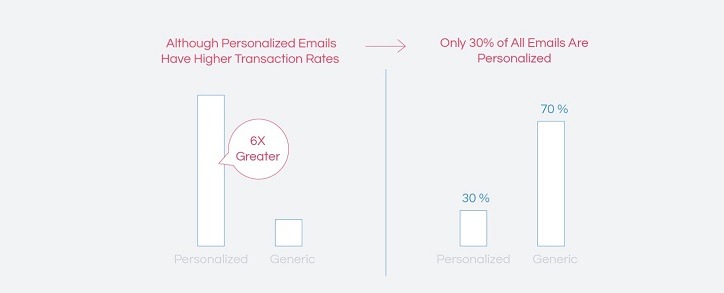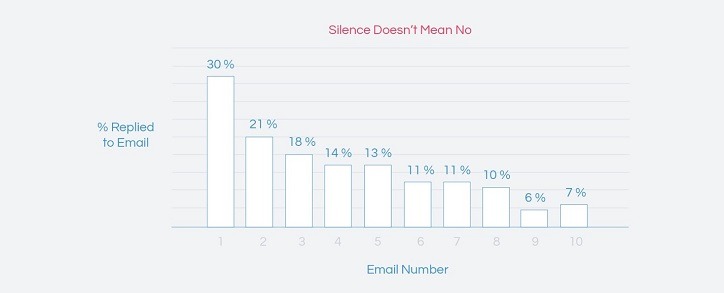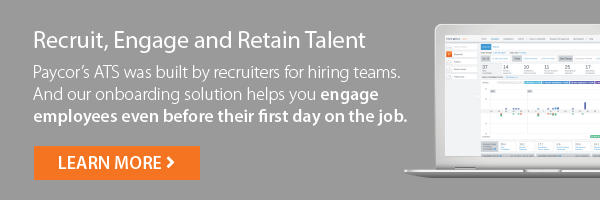10 Tips for Effective Recruiting Emails
As a recruiter, there are few tools more valuable than great recruiting emails. (That’s why Paycor Recruiting software comes with more than 90 expertly written recruiting emails, and the ability to quickly create and share your own.) Through extensive research and decades of experience in the industry, we’ve pulled together our 10 best tips for writing recruiting emails that drive engagement.
- Subject Line Is Key
- Recruiting email subject lines are like the keys to the car. No matter how nice the vehicle (quality of your recruiting email), if you don’t have the key to unlock it (a great subject line), you won’t get anywhere. Think about it. Subject lines are your first touch point with the candidate, literally serving as the gatekeeper to your recruiting emails. In fact, subject lines are so important, we devoted an entire article discussing how to write them effectively. Interested in learning more about creating subject lines that drive candidate email opens? Check out Paycor’s article on what makes up a great subject line, where we even provide our own top performing subject lines over the years.
- Get Personal
-
Okay, so you have your killer subject line and your candidates are clicking through to your recruiting email. Great first step, but your work is FAR from over. Now, that you have your audience’s brief attention (the average person only spends a couple of seconds skimming “cold” emails), you must captivate them and drive a response. So where to start?
Personalization Drives Engagement
According to studies, fully personalized messages have a 6X higher transaction rate (opens and responses), yet 70% of all company emails are not personalized. Talk about a missed opportunity! Prior to reaching out to any candidate via email, we always recommend doing your research first. Check out their professional profiles on LinkedIn, social profiles on sites like Twitter or Facebook, and even try to find any of their work samples online.

Once your research is complete, pick out specific tidbits that you found and drop them into your messaging. Not only will these crumbs of personalization generate candidate interest, but they will also show your candidate that you have invested valuable time in learning more about them. This will garner their appreciation, which makes them more inclined to respond.
Be a Person First, Recruiter Second
Another major aspect of personalization is natural communication. When writing recruiting emails, always take the approach of being a person first and a hiring professional second. Maintain a conversational tone and be sure to avoid over-formality. Step into the shoes of the candidate and ask yourself, “If I were receiving this email, how would I want to be engaged?”
- Build the Relationship
-
In extensive dealings with our clients, we have found that all too often, hiring professionals try too hard to close the candidate initially. They are so heavily focused on the position that needs to be filled and the requirements of job, that they lose sight of the most important aspect of natural engagement- building a relationship.
Why Are You Worth Their Time?
Every relationship requires a balance. In order to open up and speak with you, candidates need to be convinced that you are worth their time. Remember, with recruiting emails, it’s not about you, your company, or the position that you are hiring for. It’s all about the candidate. Having already done your research, you should know your candidate’s interests. Tailor your communication to explain how your job opportunity will allow your candidate to further tap into and pursue their passions.
- No Dumping!
-
One of the biggest mistakes in recruiting emails is information dumping. Many hiring professionals think that the best way to get a reply from a candidate is to lay everything out on the table for them- job title, duties, salary, etc. NOT THE CASE. Why? This approach feels intrusive and rude. You are assuming that a person you have never spoken with is automatically interested in speaking with you about some job you are hiring for. How presumptive! Also, too much information on a first touch is overwhelming. Think about it through a sales perspective. When first embarking upon a buying journey, you don’t want to hear the nitty-gritty technical details and product specs from a pushy salesperson. Before anything else, you want to develop a basic understanding of the product at your own pace so that you can gauge your interest. Candidates are your customers and this is their buying journey. The same rules apply.
Keep It Short and Simple!
Studies conducted by email optimization app Boomerang show that emails with a word count falling between 50-125 words have an average response rate of over 50%. Furthermore, Boomerang also found that emails written at a 3rd grade level have the highest response rates at 53%, compared with emails written at high school and college level. On your first touch, keep it short and simple. This makes your email, and by extension you, most accessible.
- Generate Curiosity
-
Information Gap Theory
When writing effective recruiting emails, talent acquisition leader Glen Cathey recommends employing the information gap theory put forth by George Loewenstein. As the theory goes, curiosity is generated when there is a disconnect “between what we know and what we want to know.” Building off of tip #4, this theory actually finds that the less information you provide, the more likely your recruiting email is to drive a response. Give your candidates the thousand foot view of your company and the role. Provide just enough information to pique their interest but remain vague about the details to create that information gap. This will induce curiosity and push candidates to want to learn more.
Surprise Your Audience
Another key to sparking candidate interest is breaking the mold. Undoubtedly, candidates that you are emailing are receiving countless other recruiting emails as well. If your recruiting email looks and reads like all the rest, how do you expect to capture your candidate’s attention? Neuroscience tells us that we become numb to stimuli that we are overexposed to. On the other hand, it has been found that surprise grabs attention and promotes heightened processing of information. Don’t be afraid to go outside the box with your communication and say something that will “shock” your candidates. The results may be shockingly good.
- Express Yourself! (Get Emotional)
-
Neuroscience also tells us that the brain feels before it thinks. Consider this- before recalling what someone said or did, you will always remember how they made you feel. Why is this? Feelings and emotions leave the greatest impression upon us.
The Harvard Business Review found that appealing to customer emotions is one of the most effective ways to drive engagement. Furthermore, IPA dataBANK uncovered that advertising campaigns appealing strictly to the emotions of customers outperform those campaigns that strictly appeal to logic by double, AND even outperforms those campaigns that appeal to both logic and emotion. In recruiting, candidates are your customers so why wouldn’t the same hold true?
Some of the strongest emotions for driving engagement are amusement, interest, humor, surprise, happiness, and delight. When drafting your recruiting emails, use messaging (or even images and links) that tap into these emotions. After all, people are creatures of emotion, not logic.
- Network, People!
-
Internally
When writing recruiting emails for a given position, it’s always good to get some insider information that may help you more effectively craft your messaging for potential candidates. Ask the person on your team who fulfills a similar role how they would liked to be engaged with. Or better yet, have that person reach out to the candidate. Having a non-recruiter send the recruiting email makes your messaging far more personalized. Additionally, if the recruiting email comes from someone fulfilling a similar role that will be a potential co-worker of the candidate, the message has far more credibility.
Externally
Always check to see if you are connected with a candidate through your professional networks. If you are, you can reach out to the mutual connection and get an early read on the candidate. Furthermore, you could ask the connection to contact the candidate on your behalf or even name drop them in your recruiting email. This goes back to the idea of personalization. A familiar name is sure to grab your candidate’s attention. Not to mention, candidates are much more likely to follow-up with a person that they know.
- Keep Mobile in Mind
-
More than 1 in 2 emails are currently opened from a mobile device and this number only continues to climb. If you want any chance at getting a response from your candidates, you must ensure that your messaging is easy-to-read on a mobile device. Always send a test email to yourself before the candidate. How does the subject line appear in your inbox? Open the email on your phone. Do you enjoy the experience? If the answer is no, then you can bet that your candidate’s will be as well.
- Follow-Up
-
Say you have employed all or some of the techniques above, you reach out to your candidate with a killer subject line and email, and then…. radio silence. Probably time to give up and move on right? ABSOLUTELY NOT! The reality is that most first-touch recruiting emails get deleted. This is okay. Silence does not mean no. Remember that people are busy and not everyone has time to go out of their way to respond to your email. This is why following-up is so crucial. You need to give candidates several opportunities to respond to your recruiting emails. Why? Consider this research from Yesware:

- Always Be Experimenting
-
The final key to writing effective recruiting emails is constant experimentation. The reality is that with recruiting emails, there is no “right” answer. People respond in different ways to the same messaging, so it is impossible to say that one recruiting email will work for all candidates. Despite this, through constant iterations of A/B testing and different forms of experimentation, you can glean insights and trends about which forms of messaging perform statistically better over time.
*Note: Even when you do find a certain methodology that seems to work best, always be tweaking it to see if you can optimize for higher response rates.
Attract & Engage Candidates with Paycor Recruiting
- Pre-written Emails Ready to Go: Paycor Recruiting comes with more than 90 expertly written recruiting emails to get you started.
- Create Branded Career Pages: Easily create a fully-branded careers site that matches your website, without IT help. Branded career sites convey a unified, trustworthy impression to candidates who might not know much about your company. First impressions matter!
- Candidate Texting: Strengthen your talent pipeline—instantly communicate with prospects, reconnect with candidates, send follow-up info and timely reminders.
Learn more at Paycor Recruiting.










